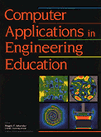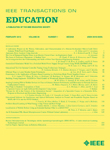Miscellaneous articles related to teaching
This section contains some of my papers somehow related to teaching. They deal with several subjects but have one common characteristic: They grew out of my experience as a teacher.
 This paper describes the results of a large-scale
experience in furthering the educative use of Information
Technology and the internet in the primary schools of northeast
Portugal. The effort, the first and still the largest of its
kind in Portugal, ultimately involved 1,137 schools, more than
1,700 teachers, and roughly 13,000 pupils.
This paper describes the results of a large-scale
experience in furthering the educative use of Information
Technology and the internet in the primary schools of northeast
Portugal. The effort, the first and still the largest of its
kind in Portugal, ultimately involved 1,137 schools, more than
1,700 teachers, and roughly 13,000 pupils.
 This paper discusses signal and image reconstruction in
the context of undergraduate Electrical Engineering education.
It presents two Java applets that have been found useful in
that context. It contains a brief review of some of the basic
signal and image reconstruction techniques. The applets can be
used as tools to teach these techniques or as a laboratory to
study the applicability of the methods to real world signals
and images. The students can do simulations with their own data
(signals or images) on any computer platform.
This paper discusses signal and image reconstruction in
the context of undergraduate Electrical Engineering education.
It presents two Java applets that have been found useful in
that context. It contains a brief review of some of the basic
signal and image reconstruction techniques. The applets can be
used as tools to teach these techniques or as a laboratory to
study the applicability of the methods to real world signals
and images. The students can do simulations with their own data
(signals or images) on any computer platform.
 The response of a homogeneous time-invariant system to an
exponential input is a similar exponential output. I noticed
this when teaching Matemática Aplicada (Applied
Mathematics) years ago, as a consequence of the approach that I
use to introduce Fourier analysis to the engineering students.
Basically, I try to show that exponentials are eigenfunctions
of linear time-invariant systems, and then look for orthonormal
sets of exponentials. I found several arguments that suggest
that linear time-invariant systems have exponential
eigenfunctions, and that require just the axiomatic definition
of linearity (no integral or convolution representation is
involved; indeed, there are linear time-invariant systems that
have no convolution representations). The simplest argument
that I know of uses homogeneity and time-invariance only. Thus,
time-invariant systems have exponentials eigenfunctions.
The response of a homogeneous time-invariant system to an
exponential input is a similar exponential output. I noticed
this when teaching Matemática Aplicada (Applied
Mathematics) years ago, as a consequence of the approach that I
use to introduce Fourier analysis to the engineering students.
Basically, I try to show that exponentials are eigenfunctions
of linear time-invariant systems, and then look for orthonormal
sets of exponentials. I found several arguments that suggest
that linear time-invariant systems have exponential
eigenfunctions, and that require just the axiomatic definition
of linearity (no integral or convolution representation is
involved; indeed, there are linear time-invariant systems that
have no convolution representations). The simplest argument
that I know of uses homogeneity and time-invariance only. Thus,
time-invariant systems have exponentials eigenfunctions.
In an interesting article (Homogeneous Time-Invariant Systems, IEEE Signal Processing Letters, vol. 6, n. 4, p. 76-77, Apr. 1999), Vaidyanathan established the invariance of exponentials for homogeneous time-invariant systems, noticed that the concepts of "impulse response" and "frequency response" are of little use for their analysis, and asked about more general classes of systems with exponential eigenfunctions.
This paper argues that the concepts of impulse and frequency response can be useless even for certain linear, time-invariant systems. It discusses the role of time-invariance, commuting linear systems, and conditions under which they have common eigenfunctions. Then it exhibits a class of nonlinear, nonhomogeneous, time-varying systems that still have exponential eigenfunctions. This class contains homogeneous time-invariant systems, FIR filters and generalized feed-forward filters as special cases. This clearly shows that the exponential eigenfunction property does not imply linearity, homogeneity, or time-invariance. This class has been enlarged in a subsequent paper (P. M. Q. Aguiar and F. M. Garcia, Systems with Exponential Eigenfunctions and Exponential-Input / Constant-Output Operators, IEEE Signal Processing Letters, vol. 7, n. 8, p. 219-220, Aug. 2000).
 The Nyquist plots of rational functions of type one or
higher are often represented with branches that tend to
infinity while approaching either the real or imaginary axis.
It is shown that this fails to be true in general. This has
pedagogical interest since it explains the discrepancy between
the shape of the Nyquist plots obtained analytically, or with
the help of computer programs in the classroom, and the plots
found in many standard textbooks. The discrepancy is most clear
when the system type is at least two, in which case the
branches may move infinitely further from both axis.
The Nyquist plots of rational functions of type one or
higher are often represented with branches that tend to
infinity while approaching either the real or imaginary axis.
It is shown that this fails to be true in general. This has
pedagogical interest since it explains the discrepancy between
the shape of the Nyquist plots obtained analytically, or with
the help of computer programs in the classroom, and the plots
found in many standard textbooks. The discrepancy is most clear
when the system type is at least two, in which case the
branches may move infinitely further from both axis.